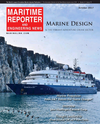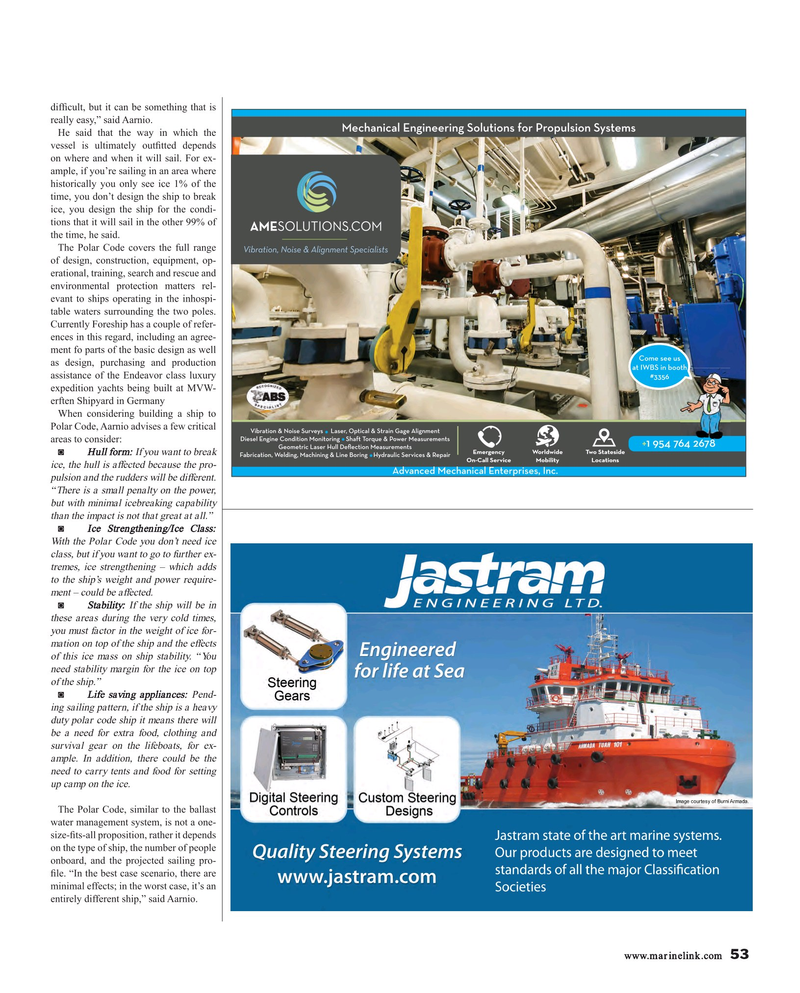
Page 53: of Maritime Reporter Magazine (October 2017)
The Marine Design Annual
Read this page in Pdf, Flash or Html5 edition of October 2017 Maritime Reporter Magazine
dif? cult, but it can be something that is really easy,” said Aarnio.
Mechanical Engineering Solutions for Propulsion Systems
He said that the way in which the vessel is ultimately out? tted depends on where and when it will sail. For ex- ample, if you’re sailing in an area where historically you only see ice 1% of the time, you don’t design the ship to break ice, you design the ship for the condi- tions that it will sail in the other 99% of the time, he said.
The Polar Code covers the full range of design, construction, equipment, op- erational, training, search and rescue and environmental protection matters rel- evant to ships operating in the inhospi- table waters surrounding the two poles.
Currently Foreship has a couple of refer- ences in this regard, including an agree- ment fo parts of the basic design as well
Come see us as design, purchasing and production at IWBS in booth th assistance of the Endeavor class luxury #3356 expedition yachts being built at MVW- erften Shipyard in Germany
When considering building a ship to
Polar Code, Aarnio advises a few critical
Vibration & Noise Surveys Laser, Optical & Strain Gage Alignment
Diesel Engine Condition Monitoring Shaft Torque & Power Measurements areas to consider: +1 954 764 2678
Geometric Laser Hull De?ection Measurements
Emergency Worldwide Two Stateside ? Hull form: If you want to break
Fabrication, Welding, Machining & Line Boring Hydraulic Services & Repair
On-Call Service Mobility Locations ice, the hull is affected because the pro-
Advanced Mechanical Enterprises, Inc.
pulsion and the rudders will be different. “There is a small penalty on the power, but with minimal icebreaking capability than the impact is not that great at all.” ? Ice Strengthening/Ice Class:
With the Polar Code you don’t need ice class, but if you want to go to further ex- tremes, ice strengthening – which adds to the ship’s weight and power require- ment – could be affected.
? Stability: If the ship will be in these areas during the very cold times, you must factor in the weight of ice for- mation on top of the ship and the effects of this ice mass on ship stability. “You need stability margin for the ice on top of the ship.” ? Life saving appliances: Pend- ing sailing pattern, if the ship is a heavy duty polar code ship it means there will be a need for extra food, clothing and survival gear on the lifeboats, for ex- ample. In addition, there could be the need to carry tents and food for setting up camp on the ice.
The Polar Code, similar to the ballast water management system, is not a one- size-? ts-all proposition, rather it depends on the type of ship, the number of people onboard, and the projected sailing pro- ? le. “In the best case scenario, there are minimal effects; in the worst case, it’s an entirely different ship,” said Aarnio.
www.marinelink.com 53
MR #10 (50-57).indd 53 MR #10 (50-57).indd 53 10/4/2017 11:00:02 AM10/4/2017 11:00:02 AM

 52
52

 54
54
